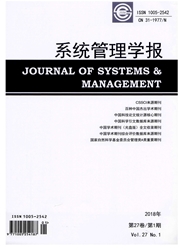

 中文摘要:
中文摘要:
根据CreditMetrics信用风险迁移矩阵的时间效应和随机过程中的Brown运动来反映银行贷款风险的非系统因素。确定信贷资产风险随时间变动的数学关系;结合因子模型与Markowitz的均值-协方差模型,建立基于存量与增量组合累计风险的银行贷款决策模型。模型的基本原理是通过对决策前贷款存量组合的风险和收益率与其加入一笔新贷款后的总风险和总收益率的对比来决定是否发放该笔贷款。模型的主要特点:①综合反映贷款存量组合累计风险对贷款决策的直接影响。合理地考虑了贷款存量组合与贷款增量的关系;②信贷资产的信用风险由扰动项定量的表示出来。而不是像流行方法那样由于因子模型的扰动项的均值为零而直接将砖设置为0;③把微观层次的风险与宏观经济变量联系起来,充分考虑宏观经济要素对微观个体还贷能力的重要影响,即综合考虑了市场风险和信用风险对信贷风险的影响。
 英文摘要:
英文摘要:
Based on time variance effect of the assets credit rating migration of CreditMetrics and the stochastic process Brownian motion, the asset nonsystematic factor of bank is determined and the mathematical relationship between credit risk and time is established. Combined with factor model and the mean-variance model of Markowitz, a loan decision-making model on existing portfolio and accumulative portfolio is set up. The basic principle of the model is that bank will decide whether to permit a new loan by comparing the existing portfolio risks and yields with the total risks and total yields when the new loan is added to the existing portfolio. There are three main merits of the model. One is that the model considers the effect of the accumulative risk of the existing portfolio of the old loans and the rational relationship between previ ous portfolio and the new added. The other is that the credit risk is quantitatively represented by perturbation item, which is commonly ignored for quantitatively analysis for the mean value of residual term is taken as zero in present methods. The third is that the market factor effects on the credit risk are considered in the model, the effects of the macro economy factors on the pay back ability of micro debtors are fully considered, that is, the market risk and credit risk are totally taken into account in the banks lending risk.
 同期刊论文项目
同期刊论文项目
 同项目期刊论文
同项目期刊论文
 期刊信息
期刊信息
